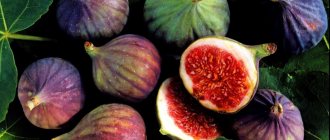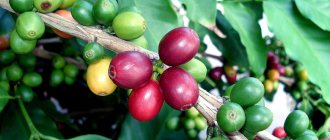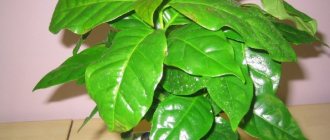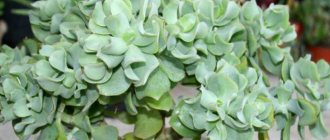- October 13, 2018
- Trees and shrubs
- Ksenia Yedikhanova
Avocados are known and loved by many, this is due to the unusual taste and high nutritional value of the fruit. Large green fruits can be purchased in almost any supermarket, but few people know how and where the avocado tree grows. Is it possible to grow an exotic crop yourself?
Appearance
What does an avocado tree look like? The plant is an evergreen tree that can reach a height of 6-18 m. The tree has ovate leaves with pointed tips, about 10-20 cm long and 2-12 cm wide, in a dark green hue. The flowers of the plant are unsightly, yellow-green in color, collected in small inflorescences in the form of umbrellas.
The avocado fruit is a green drupe with a thick, dark green skin. Its flesh is also green in color, has a slightly sweetish taste and a creamy-buttery consistency. The size of avocado fruits varies from 5 to 15 cm, depending on the degree of ripeness and variety.
The avocado tree can be of three varieties:
- West Indian - suitable for growing in tropical climates with high humidity.
- Guatemalan is a hardy species that grows in subtropical mountainous areas.
- Mexican is the most common variety due to its resistance to slight low temperatures, which other varieties cannot boast of.
Due to different varieties of culture, avocados from different countries may have slightly different appearance and taste.
Avocado tree
The results of recent studies have shown that the avocado tree purifies the air from pollution, so at home it is placed in the kitchen, bedroom or children's room.
North America is considered the birthplace of the plant, but it is grown in many other countries around the world. In Israel, it is cultivated on an industrial scale, so many consider this state to be the birthplace of avocados.
Names and life form
Avocado belongs to the class of evergreen plants of the genus Perseus of the Laurel family. The tree is also known as Persea americana and its English name is Alligator pear. It is common to the plant and the fruit.
The genus Perseus includes more than 150 evergreen plants. The life form of avocado is a tree or shrub.
The natural environment is tropical and subtropical climate, but shrubs are also found on mountain slopes, at an altitude of 600-1000 m above sea level.
Growing conditions in the natural environment
Each group of plants has its own characteristics. Mexican varieties normally tolerate variable humidity, slight cooling, and other natural disasters.
West Indian varieties, on the contrary, are vulnerable to slight drops in temperature and immediately freeze and die. In temperate climates they are grown only in greenhouses.
In their natural environment, plants grow and develop normally in open sunny areas and in the shade. Open areas are preferable as they produce the best harvest.
For seedlings in the shade, growth goes into the crown. In drafts and strong gusty winds, their development slows down. Optimal humidity is another important climatic factor, because during dry periods flower pollination is disrupted. As a result, yields are reduced.
What does an avocado tree look like?
If you compare a photo of a tree at home and in the wild, the difference is noticeable. In its natural environment, it is a large, fast-growing tree, its height varies from 10 to 20 m. At home, it rarely reaches a height of 3 m.
The trunk is straight and branched. The leaves are oval, bright green. Leaf length – 20-35 cm.
The flowers are small, light green, located in the axils of the leaves. Blooms all year round.
The fruits are pear-shaped, oval or round. The size depends on the variety - from 5 to 15 cm, weight can reach 1.5 kg. Mostly fruits weighing 250-350 g are imported.
The skin is dark green, smooth or with pimples, hard. As it ripens, its color may change to black (in some varieties). The pulp is oily, green, yellow-green or cream in color. In the center is a medium or large seed.
The appearance and growth characteristics vary depending on the varieties. Below are descriptions of the most common Persians:
- American;
- Mexican;
- Guatemalan;
- Antillean
American
American Persea (avocado) grows up to 20 m. The photograph of the tree shows that its leaves are oval, wide, with a solid edge. The length of the smallest is 8 cm, the medium is 20-25 cm, the largest is 40 cm. The width of the sheet is from 5 to 15 cm.
On top, the color of the leaves is dark green, with a glossy tint. Below – with a bluish tint. The flowers are bisexual.
The fruits are large, length reaches 15-20 cm. The color of the skin varies from dark green to brown. The pulp is fatty, oily, creamy yellow in color, with a pleasant aroma.
American Persea is a valuable fruit species; its fruits are valued for their delicate texture and taste, as well as for their composition. More than a third of it consists of healthy vegetable oils, proteins, and vitamins of all groups.
The avocado tree grows in Mexico, USA, Brazil, and Israel.
Mexican
The height of this plant usually exceeds 12 m. Rarely, specimens up to 18 m are found in nature.
The leaves smell like anise - the smell is clearly audible if you rub them with your fingers. Flowering begins at the end of March and lasts until the beginning of June.
The fruits are small – 5-10 cm long, 3-6 cm in diameter. The weight of the average fruit is 200 g. The ripening period lasts up to 7 months. The harvest is harvested in the fall. The fruits have a delicate texture, good taste, and soft skin.
The ideal climate for Mexican Persea is the highlands in the subtropics.
Guatemalan
The plant is most often found in the mountains of Guatemala and Southern Mexico. The ripening period lasts from 8 months to a year. Mass flowering begins in mid-May and lasts until mid-June.
The leaves are regular oval in shape, odorless. Ripe fruits are large, the average weight of one is 500 g. The peel is dense, dark green, with a rough surface.
The Guatemalan variety can withstand temperature fluctuations, but is inferior in frost resistance to Mexican plants.
Antilles
Antillean trees love warmth and sun; the ideal conditions for their growth are the tropics of Central America.
Flowering begins towards the beginning of summer, as well as in mid-autumn. An avocado on a tree ripens in 7-8 months. Ripe fruits have smooth, thin skin and are pear-shaped. The taste reveals sweetness and almond notes.
Avocado tree care at home
You can grow your own avocado from fresh seeds. In indoor conditions, the height of the plant rarely exceeds 2 m; in a winter garden or greenhouse it can reach 5 m.
The tree rarely blooms. The trunk is brown, at first thin and flexible, but as it grows it becomes stronger, becomes lignified, and the crown becomes spreading. The leaves are oblong, long, wide, oval in shape. Color – dark green, glossy.
The optimal conditions for normal growth of persea are as follows:
- A bright place, but without direct sunlight. If they get in, there is a high probability of sunburn of the leaves.
- The temperature varies depending on the time of year. In spring and summer, the temperature should be above room temperature, and in autumn and winter - not lower than 18-20 degrees. If it drops to 10-12 degrees, the plant will shed its leaves.
- Abundant watering in spring and summer, moderate watering in autumn and winter.
- The air humidity in the room should be high. To create and maintain it, the leaves of the plant are often sprayed, and the pot is placed on a tray with damp moss.
- The tree needs to be fertilized from the beginning of spring until the end of summer. Mineral and organic compounds are used for feeding. In autumn-winter, feeding is stopped.
Avocados grow quickly, so initially you need to select a large pot. A young tree can be replanted annually, and an adult tree can be replanted once every 3 years.
Purchase of planting material
You can try growing an avocado tree at home. To do this, you should take care of good planting material - a seed. It must be removed from ripe fruit purchased in a store. You need to choose the right avocado in order for the seed to germinate. For these purposes, only ripe fruits should be used. You can check ripeness in the following way: lightly squeeze the avocado with your palms, the fruit should take its previous shape after that. If you can’t buy ripe fruit, don’t despair, because it can always ripen at home on the windowsill.
After purchasing an avocado, the fruit itself can be eaten, because only the seed has value for germination. You need to remove it carefully so as not to damage its peel.
Planting methods
At home, an avocado tree can be grown in three ways:
- The seed is planted in loose soil with the blunt end down. It is important that the sharp end rises slightly above the surface of the ground. It is necessary to water the seedlings once every 7 days with clean water. This method is the simplest, but you will have to wait a long time for the first shoots, since the roots need to break through the hard crust of the seed.
- You need to punch three holes in the pit. After this, it is placed in water so that the holes are above the surface of the liquid. It remains in this state until germination, after which it can be placed in the ground.
- The last method involves completely clearing the seed from its shell. After this, it is placed in water until roots appear. This method is not only the fastest, but also the most interesting, since it becomes possible to observe the formation of the root system.
Regardless of the chosen method of planting an avocado seed, seedlings appear in 90% of cases, which is considered a fairly high figure.
Landing rules
A fruit tree is grown from a seed. You will need to remove the seed from the avocado, wash and dry it. There are several methods of germination.
Open germination in water
The open version involves placing the seed in a glass of water, where you can add charcoal for better filtration. First, four holes are made in the wide part of the seed along a circular path, equidistant from each other. Toothpicks are placed in them for support. There should be enough liquid in the container to leave 1/3 of the seed . The optimal water temperature is 23°C . It needs to be changed every few days. When the root (appears in a few weeks) grows to 5 cm , you need to transplant it into a pot.
Closed germination in soil
With closed germination, the seed immediately falls into the ground. To begin with, drainage is placed in the pot and watered with filtered water. Then a layer of soil is formed and loosened. The seed is planted with the sharp end up , which should protrude above the ground. 2 cm deepening . Before the sprout appears, the pot is transferred to a warm place, covered with a transparent bag.
You can make the soil yourself by mixing peat, sand and fertile soil in equal proportions. An alternative is to buy alkaline or neutral soil for tropical plants. But it’s better to add sand to it at home in equal quantities with the purchased soil.
Growing in the ground
After the avocado tree sprouts from the seed, you can begin planting it in the ground. It is recommended to use universal soil for indoor plants, as it has a sufficient amount of nutrients and a loose structure. The soil must be well drained so as not to retain excess moisture, which is detrimental to the roots.
Experienced gardeners suggest adhering to the following planting system:
- drainage must be at least 2 cm in height;
- the bone goes two-thirds into the ground with the blunt end down;
- in this case, the sharp end must remain above the surface of the earth;
- After planting, it is recommended to water the plant with warm water once a week.
To ensure good rooted growth, it is necessary to fertilize the plant once every 2 weeks. In addition, avocado is a light-loving crop, so you should take care of good lighting in the place where the pot is located.
How to grow an avocado from a seed?
It itself is quite large, about half of the entire fruit. Cut it in half and remove the pit. Rinse it under running water, removing any remaining avocado. Try not to touch the brown crust.
Once you have washed the pit, take a small container (plastic egg trays can be used) and place the pit. Be sure to ensure that the water does not cover the entire pit. If you don’t have a small container on hand, you can use a glass of water.
To prevent the pit from being completely submerged in water, insert toothpicks into the pit to prevent it from getting completely wet.
An important nuance is that the blunt end should be located in the water. If you place the pit in a transparent container, you can watch the avocado grow.
The second option is to immediately immerse the seed in the ground without soaking it in liquid. To do this, you need to peel it from the brown peel. It is best to water no more than once a week. It is important to remember that the soil should be moist, but not waterlogged.
You will have to wait quite a long time for the first sprout. Usually the seed opens and shows the first sprout a couple of weeks after it is immersed in water or immediately transplanted into the ground. As soon as the first sprout is about 3 centimeters, the avocado can be planted in the ground (if you soaked the seed in water).
In order for the plant that is transplanted into the ground to have enough air and not have stagnation of water in the ground, the soil in the pot must have good drainage. A very important nuance - the tree does not tolerate stagnation of water in the root system. The first pot may be quite small.
As soon as the tree grows, it can be safely transplanted into a larger pot. The drainage must be at least 2 centimeters high. Next, fill the drainage with soil and plant the seed so that one third protrudes from the ground.
How to care?
How does an avocado grow? Despite the fact that countries with very warm climates are considered its homeland, growing avocados from seeds at home is possible. To do this, you need to know some nuances about caring for wood.
The optimal temperature for the plant is considered to be about +23 degrees, while in winter these indicators can be reduced to +10 degrees. If the temperature is below this mark, it will be detrimental to the young plant.
Flowering begins in the third year of the tree's life. In order to subsequently obtain fruits, it is necessary to have several plants so that they can be pollinated by insects. At the same time, it is recommended to expose the tree outside to direct sunlight in the spring and summer, as this has a beneficial effect on its growth and provides an opportunity for natural pollination.
Watering should also change throughout the year:
- in spring and summer, watering is required as the soil dries;
- in winter, after the soil dries, at least 2 days must pass before the next watering.
It is recommended to use settled water at room temperature. In this case, it is necessary to add fertilizer for citrus crops to the water and fertilize it with this composition once every 2 weeks in the spring and summer.
From the moment of flowering to the formation of fruits, about 6 months pass; during this time it is important to carefully care for the plant in order to obtain high-quality fruits.
An interesting option is to plant three seeds in one pot and then weave the trunks into a braid. At the same time, it is not recommended to make it tight; you need to leave space to compact the stems.
Avocado care
Subsequently, you will understand how to care for an avocado tree. It is best to water with settled water at room temperature.
Don’t forget about the optimal mode - if you over-water, the tree will immediately signal this to you with its yellowed leaves. To remove excess moisture, do not water the plant for several days until the soil dries out.
For normal plant growth, it must be pinched. In this way, the growth of lateral shoots is stimulated and the future crown of the avocado tree is formed. Do not forget that as the plant grows, it will be necessary to replant it in a larger container.
Try to place the pot on the sunny side - avocados prefer sunlight. Avocados do not tolerate cold air.
When growing a plant, be prepared for its diseases. The most common diseases of the avocado tree are scale insects and spider mites. You can fight parasites by changing the dryness or humidity in the room.
10 best frost-resistant peach varietiesWinter-hardy varieties of apricots: the best, tasty, frost-resistant varieties
How to plant trees in the fall: timing, planting stages and varieties
You can spray the plant with a spray bottle. You can remove insects manually using a soap solution. If the branches are severely damaged, they must be removed manually.
The avocado plant gets sick due to improper watering, very cold water, drafts, and dry air.
Treatment of diseases
When growing an avocado tree at home, you should beware of the same diseases that affect many other cultivated plants:
- Phytophthora is a fungal disease that over time destroys the root system. The disease can be identified by the sudden appearance of ulcers on the trunk and leaves of the tree. After detection, the affected plant should be set aside from others and the affected parts should be pruned.
- Spider mites appear when there is high humidity in the room where the avocado grows. It can be identified by yellowing leaves and their falling off. The diseased plant must be sprayed with a soap solution and the affected parts of the tree removed.
- Powdery mildew appears as a white coating on the leaves, causing them to curl. This disease can be controlled with fungicides.
In addition, the avocado tree at home is susceptible to the same pests that affect other indoor plants. These are scale insects, whiteflies, aphids, and mealybugs.
Tree pruning
Although the avocado tree does not grow to its maximum size at home, it is necessary to periodically prune it. This way you can control its length and give it the desired shape. Trees that are not pruned have a minimum number of side shoots, grow exclusively in height and, as a result, have an unattractive appearance.
To form a beautiful crown, which can be seen in any photo of an avocado tree, pruning in a pot must be done every spring. In the first year of growth, it is important to shorten the tree after 7-8 leaves, and the side shoots after 5-6. In the future, annual pruning can increase the number of side shoots and control the height of the tree.
Brief description of care
- Air temperature and humidity . For favorable growth of avocados, constant temperature is important: the optimal level of + 25 °C should be combined with well-humidified indoor air.
- Lighting . A pot with a light-loving plant is placed on a warm windowsill. In the shade, the appearance of avocados noticeably deteriorates.
- The soil . The plant will not take root in an acidic environment, so preference should be given to a neutral mixture.
- Watering . The soil should be moderately moistened, avoiding excessive dampness. In summer, more fluid is required than in the cold season.
- Trimming . To ensure healthy plant growth, you need to trim it periodically. But do it carefully, treating the fragile tree with care.
- Bloom . At home, avocados rarely bloom. Inconspicuous small flowers gather in groups.
- Feeding . A fruitful plant does not require frequent fertilization. The soil in the pot is fed with mineral preparations.
- Transplant . Due to intensive growth, avocados must be replanted annually. Suitable period for this: spring.
Beneficial features
Despite the fact that growing a fruit-bearing avocado tree at home is quite difficult and time-consuming, the resulting fruit will undoubtedly delight you. In addition to the classic taste, they have the same beneficial properties as store-bought fruits:
- vitamins A and E;
- monosaturated fats;
- antioxidants;
- useful minerals.
Based on the totality of useful substances, avocado fruits are good in that they prevent diseases of the cardiovascular system, have a beneficial effect on the gastrointestinal tract, and are useful for diabetes and cataracts.
Despite its benefits, avocado, like most other fruits, is not hypoallergenic, so it can cause individual allergic reactions. For this reason, it is not recommended to give avocados to children under 14 years of age.
Features of a home tree
A home-grown avocado has some differences from a naturally grown avocado:
- The height of a tree in nature can reach 18 m, while the height of a home avocado reaches a limit of 2 m. At the same time, it looks quite decorative and interesting.
- It takes a lot of time and effort to create the conditions in which a tree begins to bear fruit, so most often such a tree is used exclusively for decorative purposes.
- If all conditions are created for the plant to bear fruit, its fruits are slightly inferior in size and taste to the imported ones.
- Avocados purify the air, which is why they are popular among gardeners.
In general, growing an avocado does not present any particular difficulties if there is no goal to ensure its constant fruiting.











